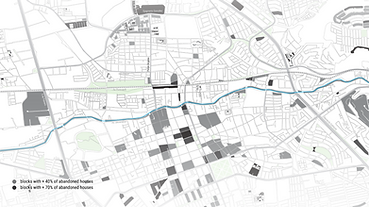MIRAR AL RÍO
A VISION TO RESTORE QUERÉTARO’S RIVER
In Collaboration with Fausto Márquez
“Mirar” in the Spanish language translates to “to look”. A conscious and deliberate act. We see everything we look at, but we don’t look at everything we see; one sees when one’s eyes are open, but one looks only when we exercise, in some matter, our will” -José Moreno de Alba-.
Querétaro River is part of the Lerma-Santiago-Pacific Hydrological Region, home to 24 million inhabitants and to the country’s largest lake: Chapala. As seen in the graphics above, the city’s main river is highly polluted, following the nation’s response to water, focusing on supply rather than in exercising a sustainable water management approach. The city has directed its efforts to overexploit the region’s aquifers and therefore build expensive infrastructure to bring water from distant sources. Neglecting the importance of maintaining quality in its water bodies, leaving most of them polluted, forgotten.
Querétaro River runs for 42.6 Km throughout the state of Querétaro
Querétaro River is originated in the “Devil’s Dam” located on the Zamorano Hill. The river crosses several localities, ranchs, agricultural and cattle fields that in many cases pour residual waters directly into the river without any treatment, causing sources of infection and pollution that degrade the river’s water quality.

The ecological recuperation of the full extension of the Querétaro River will comprise a hydrological effort that involves an intervention on the entire river’s basin. This effort should take into account the creation of strong public policies that prevent agricultural runoff and polluted waters to enter the stream bed of the river. Followed by strong investments on water treatment plants. "Mirar al Río" proposes to start with its largest urbanized piece “the first 4 Km”. In this area, the city is intersected by the river and defining the Historical District.
The Historical District of Querétaro is a UNESCO World Heritage Site
Querétaro’s Historical City Center
In 1981, UNESCO recognized the Historical Monuments' zone of Querétaro as a World Heritage Site. It is an exceptional example of a colonial town whose layout symbolizes its multi-ethnic population. It is also endowed with a wealth of outstanding buildings, notably from the 17th and 18th centuries. The urban layout is unique for Spanish colonial towns in the Americas in that its town plan was from the start divided into two distinct sections- one rectilinear and intended for Spanish settlers and the other composed of smaller, winding streets where the indigenous population lived. The area is characterized for being fundamental to the city´s economic growth, containing within its boundaries commercial, political, recreational and cultural activities that stimulate land value increments.
Source: UNESCO, Historic Monuments Zone of Queretaro, list of World Heritage Sites
The River has historically co-existed with the city of Querétaro
Historically, Querétaro’s river is the reason for the city to exist. However, there has never been a harmonic and healthy relationship between the river and the city’s urban development. Since the city was founded in the 1500’s, the river has constantly received pollutants from distinct sources, these however have not yet affected many of the environmental benefits that this now gray and fetid river still gives back to the city.
City of Queretaro, 1700-1800’s
The river is an avenue
The urban areas by the river are prone to flooding
The river is a border
Delimited both ways by a main avenue that follows the riverbed "Universidad”. With most of its surface destined to private cars, this avenue is not attractive for pedestrians or bikers, not perceived as a safe space to walk at night.
Querétaro is located in a valley between two mountain systems. Historically, it has suffered catastrophic floods. The channelized river receives storm-water from adjacent streets and sewage water coming from the historic district.
Historically, the area north of the river has been locally known as “the other side”. Representing a cultural, economic and social barrier that separates the historic center from the northern neighborhoods of the city.
Now
The vision
The River is a “No Place”
Safe urban space, not identified as a place for recreation, being used only for transit and commerce.
The River is a Drain
It regularly maintains a low flow and very little water. Receives sewage discharges from all around the city, agricultural fields and industrial parks with high levels of pollution.
The River is an Avenue
Delimited both ways by a main avenue that follows the riverbed. A border separating the historical center from the north of the city.
Population Loss
The urban area has lost population with a rate of -0.85% over the past years. It has an important number of abandoned/torn down houses.
A Segmented Area
Not an attractive nor attractor. Does not foment enjoyment, social life nor social cohesion.
A Safe and Accessible Public Space
For cultural and public expressions. A 24/7 safe space that brings health and social cohesion to the city.
An Ecologically Sustainable Habitat
A clean river with treated water, softer edges when possible. With biofilters that attract new habitats and recuperate proper animal and plant species.
An Axis for Sustainable Mobility
The city’s first “Green Street”. Oriented to public transportation that facilitates connection to the historical center, and the rest of the city.
A Catalyst for Economy and Living
With high quality public areas that incentivize retail terracing. Innovative and local commerce that helps recuperate high quality housing.
A Dynamized Public Space
The river is dynamized into a series of artistic, cultural, commercial and culinary experiences that inspire appropriation and pride in every “Queretano”.
This 4 Km strech of the river represents 50 acres of newly integrated public space for the city of Querétaro. The idea is for the space to be transformed into a dinamic public place, home to a series of unique experiences that go from a new way of moving 100% sustainably to the integration of new architectural typologies along the corridor.

01
FROM STREET TO RIVER
From Street to River is an initiative to create momentum around the river that will eventually lead to positioning Querétaro’s River in the public agenda by establishing several lines of action such as organizing a collectives' city forum along the existing public space that begins the conversation about today's challenges and potential ideas for the future. A second big step will be the renaming of the street to acknowledge the now “Universidad Avenue” to be legally called “Querétaro River”. All this focused on the main goal of the city recognizing the urban, social, and environmental functions of the river.
02
THE RIVER IS LIFE
The River is Life calls for the ecological recuperation of the river that will seek to restore its ecosystem and guarantee an ecologically healthy habitat for all the species that have been displaced. Works such as dredging the river and damns, clossure of all sewage water discharges and biofilter installations, as well as the construction of various water treatment plants are all part of this big change.
03
FROM AVENUE TO RIVERWAY
From Avenue to Riverway is an idea to revert the “mobility pyramid” and pursue the right to move sustainably by restricting the transit of private vehicles and designate the right space for pedestrian, cyclists, as well as public and shared transportation systems that create the adequate conditions for the safe enjoyment of the river’s public space.
04
FROM CONCRETE TO PARK
Today, the city of Querétaro counts with scarce 4.8m²/inh of green areas, in comparison to a city like New York with 23m²/inh.
Located in the western limits of the city's central district, a vacant site has been chosen to begin the transformation of the river corridor by adding a new urban park.
Utilizing the area of the current "Rio Ayutla" street, the river is amplified into a new urban public park with metropolitan centrality that not only contributes to increasing the green infrastructure of the city, but will also become a testbed for water treatment and flood management strategies and technologies. The idea of positioning Querétaro river as a highly valuable resource and acknowledging its character of an undermined jewel that sits in the heart of the city will set the stage for the completion of the project.

1. The River

2. The Park

3. The Street Shift

3. The Park Extension
05
THE RIVER IS GOLD
The River is Gold proposes to strengthen the rapid & sustainable reopening of all commercial units in the area that will detonate in jobs and bring proximity services, as well as incentivize the housing recuperation and inclusive resettlement of the area.
HOW IT ALL STARTED
2019.10.10 SOM | SOM-TEC Workshop | SOM Chicago
In a collaboration with the School of Architecture and Design at the Monterrey Institute of Technology, we were part of the jury during the mid-term review hosted in SOM’s Chicago office.
2019.01.15 | ITESM Querétaro | Projects for Cities of the Future | SOM Public Lecture
Invited by the Monterrey Institute of Technology, we had the chance to talk about the future of city design. We talked about the role that we as designers take when we focus our work into shaping the adequate ecosystems that will promote a sustainable development within the built environment while we face challenges mainly caused by overpopulation and climate change. We then translated to sharing our thoughts about the importance of urban planning in the city of Querétaro.
2019.12.05 | No Small Thinking | NEU University | Public Lecture
Invited by the University of New Element in Querétaro, I had the oportunity to share about our experience as urban designers in a city like Chicago, to then open the conversation towards ideas around the future of urban design for the city of Querétaro based on our understanding of the current challenges and emphasizing on the potential to design an integral Master Plan that ensures the city’s future
The lecture was based on the existing planning and design principles that have made Chicago a worldwide example of a well-planned city. There were 4 lessons that we seeked to communicate from our experience as city designers: the importance of a Big Plan, the value of memorable imagery, the significance of designing with local sensitivity, and the need of finding new ways to colaborate.
2019.12.10 | No Small Thinking | Querétaro's College of Architects | Public Lecture
I had the chance to speak at one of the monthly work sessions from the State College of Architects. A discussion was formed around big concerns such as social gentrification and government corruption thought to be the main barriers preventing good urban design to happen in the city, limiting the allocation of budget for the proper urban infrastructure.
2020.02.06 | Water as the Driver of Urban Design | EAS Querétaro 2020 | Pannel Discussion
Invited by the Secretary of Sustainable Development in the state of Querétaro, I had the opportunity to introduce the issue of water management in the city. Referencing the history of the river and the city’s development, we could come to the conclusion that even if this body of water was the reason for the city’s existence, it has never had a harmonic relationship with its built environment. The river represents a border, serves as one of the drains of the city, carrying sewage water and considered an uncomfortable and unsanitary place to be. The idea of calling for a campaign of awareness and the initiation of a project began here.
.
© 2020



















.png)











































